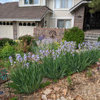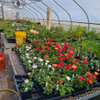Spider Mites and Powdery Mild Have Taken Hold
garnergarden
9 years ago
Related Stories

EARTH DAYHow to Help Your Town’s Beneficial Birds and Bugs
Make a habitat using local materials to provide a home to the creatures that help our gardens
Full Story
HOUSEKEEPINGCan-Do Cleaning Strategies for Busy People
While you dream of having a maid (to go with the cook and chauffer), this simplified cleaning routine can keep your real-world home tidy
Full Story
HOUSEPLANTS8 Essentials for Healthy Indoor Plants
Houseplants add so much to our homes — and can thrive when grown in the right conditions. Keep these tips in mind
Full Story
HOUSEPLANTSMeet a Palm That's Fine With Fluorescent Light
Get the look of the tropics without the full-on sun and high humidity — parlor palm tolerates regular indoor conditions with aplomb
Full Story
HOUSEPLANTSIndoor Winter Gardens for Cheerier Days
Bring plants inside for drab-days mood boosting — not to mention cleaner indoor air and protection for your greenery
Full Story
FARM YOUR YARDHello, Honey: Beekeeping Anywhere for Fun, Food and Good Deeds
We need pollinators, and they increasingly need us too. Here, why and how to be a bee friend
Full Story
BEDROOMS11 Reasons to Love White Bedding
For easy bedding that makes neutrals sing and accessories pop, look to the white side
Full Story
FURNITUREHow to Keep Your Upholstery Looking Good
You wouldn't expect your car to maintain itself. Show your sofa and chairs the same courtesy with this 3-part strategy
Full Story
OUTBUILDINGSThe Glass-Walled Cabin That Romance Built
Envisioning sunsets and starry skies, newlywed artists construct a 1-room retreat on a family farm
Full Story
More Discussions








treebarb Z5 Denver
david52 Zone 6
Related Professionals
Barrington Hills Landscape Architects & Landscape Designers · Fort Lee Landscape Architects & Landscape Designers · Mountain Brook Landscape Architects & Landscape Designers · Gainesville Landscape Contractors · Concord Landscape Contractors · Tempe Landscape Contractors · Fruit Heights Landscape Contractors · Hayward Landscape Contractors · Lexington Landscape Contractors · Mendota Heights Landscape Contractors · Porterville Landscape Contractors · San Benito Landscape Contractors · Wilsonville Landscape Contractors · Roselle Park Solar Energy Systems · Wasco Solar Energy SystemsgarnergardenOriginal Author
ZachS. z5 Platteville, Colorado
digit
garnergardenOriginal Author
bugdoctor
garnergardenOriginal Author
bugdoctor
garnergardenOriginal Author
bugdoctor